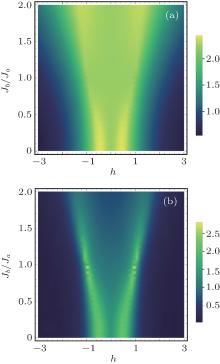†Corresponding author. E-mail: yqma@bistu.edu.cn
*Project supported by the National Natural Science Foundation of China (Grant Nos. 11404023 and 11347131).
We investigate the ground-state Riemannian metric and the cyclic quantum distance of an inhomogeneous quantum spin-1/2 chain in a transverse field. This model can be diagonalized by using a general canonical transformation to the fermionic Hamiltonian mapped from the spin system. The ground-state Riemannian metric is derived exactly on a parameter manifold ring S1, which is introduced by performing a gauge transformation to the spin Hamiltonian through a twist operator. The cyclic ground-state quantum distance and the second derivative of the ground-state energy are studied in different exchange coupling parameter regions. Particularly, we show that, in the case of exchange coupling parameter Ja = Jb, the quantum ferromagnetic phase can be characterized by an invariant quantum distance and this distance will decay to zero rapidly in the paramagnetic phase.
Quantum phase transitions (QPTs) are driven purely by the quantum fluctuations when a parameter of the Hamiltonian describing the system varies.[1– 3] Traditionally, QPTs can be well understood in the framework of the Landau– Ginzburg– Wilson paradigm by resorting to the notions of local-order parameter, long-range correlations and the symmetry breaking. In the past few years, a lot of efforts have been devoted into understanding the QPTs from the information-geometry perspectives, [4, 5] such as quantum entanglement, [6– 9] entanglement entropy, [10, 11] quantum discord, [12– 14] quantum fidelity and fidelity susceptibility, [15– 21] Berry phase[22– 32] and the quantum geometric tensor (QGT).[33– 41]
Generally, QPTs can be witnessed by some qualitative changes of the ground-state properties when some parameters of the Hamiltonian move across the quantum critical point (QCP). The underlying physical mechanism lies in the fact that the different phases are unconnected by the adiabatic evolution of the ground state. In the vicinity of the QCP, the ground state driven by the parameters of the Hamiltonian will lead to an avoided energy-level crossing between the ground state and the first excited state, where the adiabatic evolution can be destroyed by a vanishing energy gap as the system size tends to infinity. From the perspective of the information geometry, a monopole as a gapless point in the Hamiltonian parameters space will generate interesting effects on the ground-state local or topological properties. The local properties can be captured by some local quantities, i.e., the fidelity susceptibility and the Berry curvature. The topological properties will be captured by some topological quantum numbers, i.e., the Chern number, [42, 43]Z2 number, [44– 47] and recently the Euler number of the Bloch states manifold.[48– 51]
Recently, the concept of quantum geometric tensor based on the information-geometry[52, 53] of the ground state has been introduced to understand the QPTs in quantum many-body systems.[37– 41] What is surprising is that the two approaches of the ground-state Berry curvature and the fidelity susceptibility as some witness to QPTs are unified. Specifically, the real part of the QGT is a Riemannian metric defined in the parameter manifold which has been recognized as the essential part of the fidelity susceptibility. Meanwhile its imaginary part is the Berry curvature whose flux gives rise to the Berry phase. Generally speaking, the Riemannian metric and the Berry curvature will exhibit some singularity or scaling behavior in the quantum critical region under the thermodynamic limit. Particularly, a scaling analysis of the ground-state quantum geometric tensor in the vicinity of the critical points has been performed. So far, these approaches have been applied to detect the phase boundaries in various systems.
In this work, we propose a cyclic quantum distance of the ground state to detect the QPTs in a transverse field inhomogeneous Ising spin-1/2 chain, [54, 55] in which the nearest-neighbor exchange interactions will take alternating parameters between the neighbor sites. This model can be solved exactly by introducing a general canonical transformation to diagonalize the fermionic Hamiltonian mapped from the spin Hamiltonian by the Jordan– Wigner transformation. In our scheme, an extra local gauge transformation is performed to the spin system by a twist operator, which endows the Hamiltonian of the system with a topology of a ring S1 without changing its energy spectrum. We obtain the exact expression of the ground-state Riemannian metric and study the cyclic quantum distance of the ground state on the parameter manifold. We study extensively the ground-state Riemannian metric in different parameter regions of the inhomogeneous Ising chain. Particularly, we show that the quantum ferromagnetic phase in the uniform Ising chain can be marked by an invariant cyclic quantum distance of the ground state, and meanwhile, this distance will decay to zero rapidly in the paramagnetic phase.
Let us consider an inhomogeneous two-sublattice Ising spin-1/2 chain in an external magnetic field, which consists of N cells with two sites in each cell. The Hamiltonian reads

where 









Note that the PBC on the spin degrees of freedom 





This Hamiltonian H(φ ) can be exactly diagonalized as

by using the following canonical transformation:
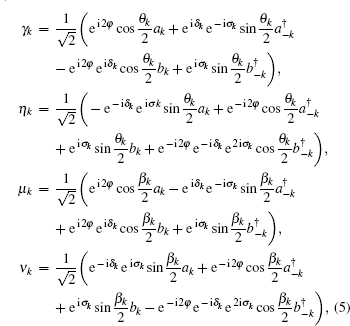
where
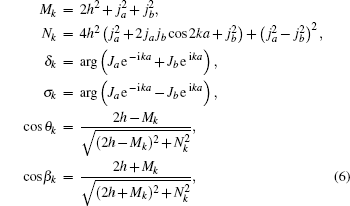
and the quasi-particle energy spectrums are

Now, we focus on the geometric properties of the ground state. The Hamiltonian H(φ ) in Eq. (4) has been diagonalized in the set of quasi-particle number operators, which allows us to determine all the eigenvalues and eigenvectors. We note that the energy spectrums Λ η k ≥ 0, Λ ν k ≥ 0 and Λ γ k ≤ 0, Λ μ k ≤ 0. The ground state, denoted as | g(φ )〉 , corresponds to the state with the lowest energy, which consists of a state with no η and ν fermions occupied but with γ and μ fermions occupied. Explicitly, the ground state can be constructed as follows:

where 



Now, we introduce the notion of the quantum geometric tensor of the ground state on the Hamiltonian parameter φ manifold. It can be verified that the quantum geometric tensor can be derived from a gauge invariant distance between two ground states on the U(1) line bundle induced by the quantum adiabatic evolution of the ground state in the parameter φ space. The quantum distance dS between two ground states | g(φ )〉 and | g(φ + δ φ )〉 is given by dS2 = 〈 ∂ φ g(φ )dφ | ∂ φ g(φ )dφ 〉 . Note that the term | ∂ φ g(φ )〉 can be decomposed as 



The concrete expression of Qφ φ can be derived by substituting Eq. (8) into Eq. (10). Obviously, the straightforward calculation is tedious, however, it can be derived concisely from the following consideration. Notice that the term 〈 g(φ )| ∂ φ g(φ )〉 is nothing but the Berry– Simon connection of the ground state, which can be calculated by considering that each term as 



In order to calculate the term of 〈 ∂ φ g(φ )| ∂ φ g(φ )〉 , we note that 

Substituting Eqs. (11) and (12) into Eq. (10), we can finally obtain the result as

Now, let us focus on the characterization of the geometric properties for the ground state. In our approach, the ground state | g(φ )〉 is defined in a U(1) line bundle located over a one-dimensional parameter manifold S1, and hence the Riemannian metric as the real part of the QGT is just Qφ φ itself. As discussed above, the ground-state Riemannian metric provide a gauge invariant distance measurement of the ground state on the parameter φ manifold. The quantum distance l between two ground states | g(φ A)〉 and | g(φ B)〉 is given by

To have an explicit view of the dependence of the Riemannian metric on the system size, we can perform a scaling transform to the Qφ φ and denote the Riemannian metric as 𝒢 φ φ = Qφ φ /Ld = [∑ k> 0 (sin2θ k + sin2β k)]/N, where Ld = N as the number of the site and here d = 1 is the dimension of the system. To study the quantum criticality, we are interested in the properties under the thermodynamic limit as N → ∞ , and we have the Riemannian metric

where the summation (∑ k> 0)/N has been replaced by the integral 

In Fig. 1(a), we plot the cyclic quantum distance l(0, π ) as a function of h and α = Jb/Ja with the system size N → ∞ . As a comparison, we also provide numerical results of the second derivative of the ground-state energy with respect to h, as a function of Jb/Ja and h with the system size N = 1001 (see Fig. 1(b)). The cyclic quantum distance l(0, π ) as a function of the external field h with the fixed parameters Ja = 1 and Jb = 1.5 is shown in Fig. 2. In the region of the inhomogeneous coupling Ja ≠ Jb, the cyclic quantum distance and the Riemannian metric have similar trends with the second derivative of the ground-state energy.
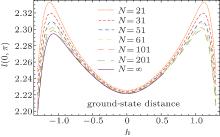 | Fig. 2. The cyclical quantum distance l(0, π ) as a function h with the fixed parameters Ja = 1 and Jb = 1.5, and with different system sizes. |
It is worth reminding that, in the uniform exchange coupling case Ja = Jb = 1 and the system size N → ∞ , the ground-state Riemannian metric 𝒢 φ φ can be exactly solved as

which leads to an invariant ground-state cyclical distance 

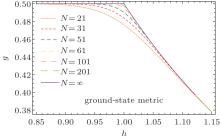 | Fig. 3. The Riemannian metric g as a function of h with the fixed parameters Ja = Ja = 1, and with different system sizes. |
For a measurable consequence of the Riemannian metric, it has been recently shown that the quantum geometric tensor of the Bloch bands can be measured by the current noise spectrum of the band insulators. The current noise spectrum can be expressed as (Eq. (13) in Ref. [40])

where Ω BZ denotes the volume of the Brillouin zone and d denotes the dimension of the quasi-momentum space. The current noise spectrum is just defined as the Fourier transform of the current– current correlation function

On the other hand, Marzari and Vanderbilt[49] have pointed out that the integral of the trace of the Riemannian metric over the Brillouin zone can be regarded as a gauge invariant measure

of the delocalization or spread of the Wannier functions.
It is worth noting that the metric component Qφ φ of the Bloch band is closely related to the ground-state quantum distance in the parameter φ space. In fact, the ground state | g(φ )〉 is π periodic in the parameter φ . In the condition of the large sites limit N → ∞ , a cyclic ground-state distance lGS along the φ -ring can be calculated as 



The relation between the cyclic ground-state distance lGS and the Euler number χ of the Bloch band illustrates that the cyclic ground-state distance is an intrinsic property of the Bloch bands. Meanwhile, this relation also tells us that the cyclic ground-state distance lGS in the ferromagnetic phase of a uniform Ising chain is equivalent to the topological Euler number of the band in the quasi-momentum space.
In summary, we study the ground-state geometric properties of a two-sublattice quantum Ising chain in a transverse field. In particular, we introduce a gauge transformation to the spin system by a twist operator, which endows the Hamiltonian of the system with a topology of a ring S1 without changing its energy spectrum. The advantages of introducing the twist parameter is that the Hamiltonian describing the system 

On the φ parameter manifold S1, we derive the exact expression of the ground-state Riemannian metric and define a cyclic quantum distance of the ground state. We study extensively the ground-state Riemannian metric and the cyclic quantum distance in different parameter regions of the two-sublattice Ising chain. Furthermore, we show that the ferromagnetic phase of a uniform Ising chain can be characterized by an invariant quantum metric Gφ φ = 1/2 and this metric will decay to zero with h− 2 in the paramagnetic phase. While the metric Gφ φ is continuous in the critical point, the singularity will appear when we take the derivative of Gφ φ with respect to the external field h. This approach provides an intrinsic description of the geometric properties of the ground state. We hope that the current work will raise renewed interest in the understanding of the geometric nature of the ground state in quantum condensed-matter systems.
| 1 |
|
| 2 |
|
| 3 |
|
| 4 |
|
| 5 |
|
| 6 |
|
| 7 |
|
| 8 |
|
| 9 |
|
| 10 |
|
| 11 |
|
| 12 |
|
| 13 |
|
| 14 |
|
| 15 |
|
| 16 |
|
| 17 |
|
| 18 |
|
| 19 |
|
| 20 |
|
| 21 |
|
| 22 |
|
| 23 |
|
| 24 |
|
| 25 |
|
| 26 |
|
| 27 |
|
| 28 |
|
| 29 |
|
| 30 |
|
| 31 |
|
| 32 |
|
| 33 |
|
| 34 |
|
| 35 |
|
| 36 |
|
| 37 |
|
| 38 |
|
| 39 |
|
| 40 |
|
| 41 |
|
| 42 |
|
| 43 |
|
| 44 |
|
| 45 |
|
| 46 |
|
| 47 |
|
| 48 |
|
| 49 |
|
| 50 |
|
| 51 |
|
| 52 |
|
| 53 |
|
| 54 |
|
| 55 |
|
| 56 |
|



